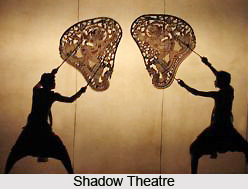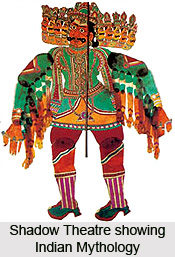 Shadow Theatre in Karnataka or Shadow-play is an interesting experiment as a specialised technique in play production. It has every accessory of a regular stage play with a theme and playing actors; but here, the spectator beholds not the actor in flesh and blood but only his shadow in black on the white screen Unlike as in the Folk-theatre of Karnataka, wherein the coloured image is manipulated into performing the drama, the modern shadow play is enacted by amateur actors behind a fixed white screen that covers the entire stage. With the help of a powerful lamp, the shadows of the actors are made to fall on the screen in sharp features. The artist synchronises his words or songs with gestures which are to an extent, exaggerated. Delicate facial expressions are of no avail in the shadow play. The actor has to move his limbs with a planned perfection so that the shadow can convey the desired action. He stands close to the screen so that his Shadow in profile falls on it, and he moves only forward and backward along the screen, close to it, for if he moved even slightly out of his marked path towards the light, his shadow suddenly grows in size. He has to be equally careful in the movement of his limbs, for, a hand half extended may produce a shadow where it looks as though the hand is sticking out of the stomach. The actor in the shadow play is perhaps more a technician than an artist. An intelligent employment of delicate dance postures and movements will bring considerable charm to the shadow play.
Shadow Theatre in Karnataka or Shadow-play is an interesting experiment as a specialised technique in play production. It has every accessory of a regular stage play with a theme and playing actors; but here, the spectator beholds not the actor in flesh and blood but only his shadow in black on the white screen Unlike as in the Folk-theatre of Karnataka, wherein the coloured image is manipulated into performing the drama, the modern shadow play is enacted by amateur actors behind a fixed white screen that covers the entire stage. With the help of a powerful lamp, the shadows of the actors are made to fall on the screen in sharp features. The artist synchronises his words or songs with gestures which are to an extent, exaggerated. Delicate facial expressions are of no avail in the shadow play. The actor has to move his limbs with a planned perfection so that the shadow can convey the desired action. He stands close to the screen so that his Shadow in profile falls on it, and he moves only forward and backward along the screen, close to it, for if he moved even slightly out of his marked path towards the light, his shadow suddenly grows in size. He has to be equally careful in the movement of his limbs, for, a hand half extended may produce a shadow where it looks as though the hand is sticking out of the stomach. The actor in the shadow play is perhaps more a technician than an artist. An intelligent employment of delicate dance postures and movements will bring considerable charm to the shadow play.
 The method of make-up is entirely different in the shadow play, for it is not the actor but his shadow that is to be presented to the audience. Paints are unnecessary: costumes are all. Most of the artist`s ornaments and costumes are made of thick paper where in attractive designs are cut. They are tied to him with threads. The shadow play provides immense possibilities in presentation. Within a split second the little "dwarf" on the screen could become by moving towards the light a fantastically huge figure occupying it entirely like the great Vamana who filled earth and heaven.
The method of make-up is entirely different in the shadow play, for it is not the actor but his shadow that is to be presented to the audience. Paints are unnecessary: costumes are all. Most of the artist`s ornaments and costumes are made of thick paper where in attractive designs are cut. They are tied to him with threads. The shadow play provides immense possibilities in presentation. Within a split second the little "dwarf" on the screen could become by moving towards the light a fantastically huge figure occupying it entirely like the great Vamana who filled earth and heaven.
As in the trick photography, giants and normal men can be brought together on the screen of the shadow play. Alladin can be made to talk to his giant, make him disappear and appear as he desires; all this as realistically as you please. Exploiting these possibilities, Karanth wrote and produced three shadow plays with great effect, Rakta Kanike dealt symbolically with economic inequality, Devi Dehi told the story of the downtrodden Hindu woman and her ultimate emancipation, and Hiriya Devaru had for its theme the liberation of man from the shackles of blind faith. In all these plays Karanth tried new experiments in the shadow technique with considerable success. A great illusion was created in the play Devi Dehi, where Sumane, Surame and Sujale who were infuriated by the treatment given to them by man, raised themselves into a huge stature of immense strength and joined together to form one colossal super-human being with three heads and six arms. Karanth`s Lava Kusa also, which has the armies and warfare in it, made a great impression in its shadows on the screen. The shadow-play deserves every encouragement from theatre lovers, for it both brings a fresh charm to our stage and provides a new scope for fantasy.




